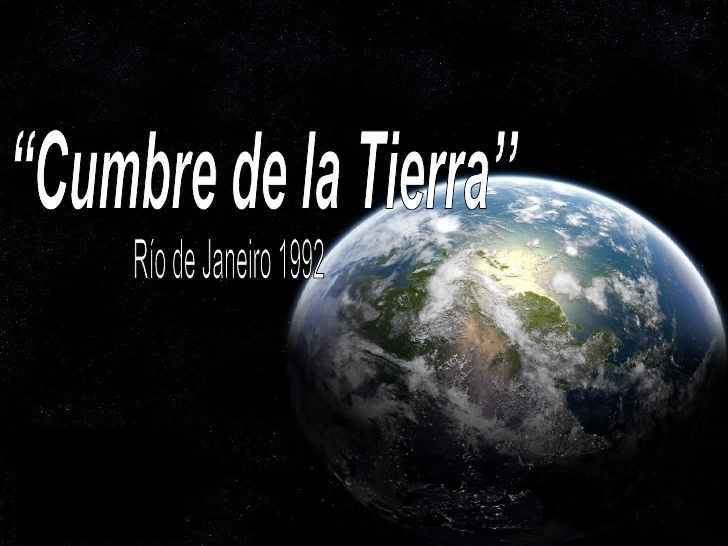
January 1, 1994
Enters into force the UNFCCC (UN Framework Convention on Climate Change).
Today it has been ratified by 195 countries, making it almost universal.
UN Framework Convention on Climate Change (UNFCCC) Rio de Janeiro
General framework of instruments to set emission limits and realize international cooperation. The objective is to stabilize concentrations of greenhouse gases in the atmosphere at a level that would prevent inteferrencia of human activities on the climate system. That level should be achieved within a timeframe sufficient to allow ecosystems to adapt naturally to climate change, to ensure that food production is not threatened and to enable economic development to proceed in a sustainable manner.
December 1, 1997
COP 3. The Kyoto Protocol was adopted with 150 signatory countries
It is the legal instrument that translates the Convention into a binding agreement with quantified commitments to reduce emissions for developed countries. The reduction in assembly must achieve is at least 5%, in the period from 2008-2012, compared to 1990 emissions market mechanisms are established to enable countries that do not meet the committed reduction they can compensate by purchasing emission rights to other countries. The Kyoto Protocol must be ratified by each nation, and the ratification of a sufficient number of responsible for at least 55% of CO2 emissions industrialized countries is needed. With Russia’s ratification in November 2004 this percentage is reached and come into force in 2005.
November 13, 2000
COP 6. The Hague and Bonn
After a first attempt failed negotiations undertaken in The Hague to finalize mechanisms and joint actions, countries meet again in Bonn with the result that the nations except USA, agree on mechanisms to implement the Kyoto Protocol . US withdraws from the Kyoto Protocol and participates with observer status only country.
December 3, 2007
Bali COP13
The “road map” that sets the stage for that in 2009 there is a new global agreement (including USA) to replace the Kyoto Protocol from 2013. Despite the insistence of developing countries and social organizations set , is not achieved the necessary reductions range for industrialized countries, according to the recommendations of the 4th IPCC report reflects (reductions between 25 and 40% in 2020 compared to those in 1990)
December 12, 2009
COP15 Copenhagen
Failure. Not achieved to adopt a new global climate agreement to replace the Kyoto Protocol when it expires in 2013. frustrates the hopes of people who had their eyes on this important event. Reinforces injustice with the poor. The Green Climate Fund was created but funding commitments are located at 2020 are not set by the countries to ensure that commitments do not exceed 2 of rising global temperatures. Countries are not legally commit to reducing their emissions or actions to combat climate change, having a merely voluntary.
November 29, 2010
COP 16 Cancún
Positive but insufficient step. Confidence in global negotiations recovers. The industrialized countries recognize the need to reduce their emissions from 25 to 40% by 2020 and to be much more than the reduction pledges of the Copenhagen Accord for limiting temperature increase to 2 ° C requires. Supports the global “green climate fund” as agreed in Copenhagen, but not innovative sources of funding are identified.
28 November 2011 – 28 March 2020
Durban COP17
The creation of an international legal framework to 2015, which would not take effect until 2020. No significant progress in terms of economic resources which will provide the “Green Climate Fund” is delayed ..
November 11, 2013
COP 19 Warsaw
The lobby of fossil fuels, especially coal and voice becomes relevant at this summit and the result is that the negotiations remain stalled. NGOs left the summit in protest at the lack of progress on agreements.
September 1, 2014
NY
Clear public support to the fight against climate change. Numerous demonstrations around the world, with the epicenter in New York where more than 400,000 people took to the streets to demand more ambitious and urgent action on climate change. Large private sector companies, finance and local government in the Climate Summit convened by Ban Ki Moon.
November 1, 2014
Fifth report of the IPCC
Intergovernmental Panel on Climate Change). The science is clear about the human origin of the emissions that cause climate change and the urgent need to change course to avoid catastrophic climate impacts also shows that there are options and opportunities for transformation, and that delaying action entails higher economic costs , environmental and social.
June 1, 2015
COP 20 Lima
Legal forms a “treaty”, “another legal instrument” or “agreed outcome” • how they will check the ambition of the contributions made by countries to ensure that as a whole the increase in temperature of 2 ° C is avoided and equity thereof with respect to their responsibility and capacity. • Neither the roadmap defined to provide the Green Climate Fund $ 100,000 million for 2020 which governments pledged five years ago in Copenhagen. • At the insistence of developing countries it has been included that in addition to reducing emissions, the new agreement should include adaptation, financing, technology transfer and support for training, but it is unclear how it will be done.
December 1, 2015
Paris COP 21. What you are at stake?
The COP of Paris is an opportunity to boost the development model to deliver us from the worst impacts of climate change. To do this we need the new global agreement is based on science and equity that includes review mechanisms to increase ambition, and the roadmap for urgent capitalization Green Background As the new agreement will enter into force in 2020 is important also that in these negotiations is achieved ambition 2020 Pre increase and additional actions that allow getting 25% and double the US ER 2020 are contemplated.
